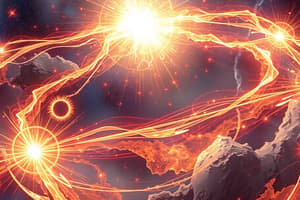Podcast
Questions and Answers
Which fundamental force is the weakest among the four?
Which fundamental force is the weakest among the four?
- Weak Nuclear Force
- Strong Nuclear Force
- Electromagnetic Force
- Gravitational Force (correct)
What does the second law of Newton's Laws of Motion state?
What does the second law of Newton's Laws of Motion state?
- For every action, there is an equal and opposite reaction.
- An object's speed is constant unless acted upon.
- An object at rest stays at rest.
- The force is equal to mass multiplied by acceleration. (correct)
Which type of energy is described by the equation $PE = mgh$?
Which type of energy is described by the equation $PE = mgh$?
- Kinetic Energy
- Mechanical Energy
- Thermal Energy
- Potential Energy (correct)
What is the main assertion of the second law of thermodynamics?
What is the main assertion of the second law of thermodynamics?
Which property of waves is defined as the distance between consecutive crests?
Which property of waves is defined as the distance between consecutive crests?
What does Ohm's Law relate?
What does Ohm's Law relate?
Which statement about the theory of relativity is true?
Which statement about the theory of relativity is true?
Which force is mainly responsible for holding protons and neutrons together in the nucleus?
Which force is mainly responsible for holding protons and neutrons together in the nucleus?
Flashcards are hidden until you start studying
Study Notes
Key Concepts in Physics
Fundamental Forces
-
Gravitational Force:
- Attraction between masses.
- Weakest of the four forces.
-
Electromagnetic Force:
- Interaction between charged particles.
- Responsible for electricity and magnetism.
-
Strong Nuclear Force:
- Holds protons and neutrons together in the nucleus.
- Strongest force but acts over very short distances.
-
Weak Nuclear Force:
- Responsible for radioactive decay and neutrino interactions.
- Short-range force.
Laws of Motion (Newton's Laws)
-
First Law (Inertia):
- An object at rest stays at rest, and an object in motion stays in motion unless acted upon by a net external force.
-
Second Law (F=ma):
- The force acting on an object is equal to the mass of the object multiplied by its acceleration.
-
Third Law (Action-Reaction):
- For every action, there is an equal and opposite reaction.
Energy Concepts
-
Kinetic Energy (KE):
- Energy of an object in motion; KE = 1/2 mv².
-
Potential Energy (PE):
- Energy stored in an object due to its position or state; PE = mgh (for gravitational).
-
Conservation of Energy:
- Energy cannot be created or destroyed, only transformed from one form to another.
Thermodynamics
-
First Law:
- Energy cannot be created or destroyed; ΔU = Q - W (Change in internal energy = heat added - work done).
-
Second Law:
- Entropy of an isolated system always increases; energy transformations are not 100% efficient.
-
Third Law:
- As temperature approaches absolute zero, the entropy of a perfect crystal approaches zero.
Waves and Oscillations
-
Wave Properties:
- Wavelength, frequency, amplitude, speed.
-
Types of Waves:
- Mechanical (require medium) and electromagnetic (do not require medium).
-
Sound Waves:
- Longitudinal waves that travel through compressions and rarefactions in a medium.
Electricity and Magnetism
-
Ohm's Law:
- V = IR (Voltage = Current x Resistance).
-
Coulomb’s Law:
- The force between two charges is proportional to the product of the charges and inversely proportional to the square of the distance between them.
-
Magnetic Fields:
- Produced by moving electric charges and can exert forces on other moving charges.
Modern Physics
-
Theory of Relativity:
- Special Relativity: Time dilation and length contraction occur at high speeds.
- General Relativity: Gravity is the curvature of spacetime caused by mass.
-
Quantum Mechanics:
- Describes the behavior of particles at the atomic and subatomic level.
- Key concepts include wave-particle duality, uncertainty principle, and quantization of energy.
Important Units
- SI Units:
- Length: meter (m)
- Mass: kilogram (kg)
- Time: second (s)
- Force: Newton (N)
- Energy: Joule (J)
Measurement and Experimentation
-
Scientific Method:
- Observation, hypothesis, experimentation, analysis, conclusion.
-
Error and Uncertainty:
- Precision vs. accuracy; systematic vs. random errors.
These notes encompass essential principles and concepts within the field of physics, providing a structured overview for study and review.
Fundamental Forces
- Gravitational Force: Attraction between masses, the weakest force among the four fundamental forces.
- Electromagnetic Force: Interaction between charged particles; essential for electricity and magnetism.
- Strong Nuclear Force: Binds protons and neutrons in the atomic nucleus; the strongest force, effective only at very short ranges.
- Weak Nuclear Force: Governs radioactive decay and neutrino interactions; short-range force.
Laws of Motion (Newton's Laws)
- First Law (Inertia): States that objects remain at rest or in uniform motion unless acted upon by an external force.
- Second Law (F=ma): Defines force as the product of mass and acceleration, emphasizing the relationship between them.
- Third Law (Action-Reaction): Asserts that every action has an equal and opposite reaction.
Energy Concepts
- Kinetic Energy (KE): Energy associated with motion, calculated using the formula KE = 1/2 mv².
- Potential Energy (PE): Energy stored due to position or state, commonly expressed as PE = mgh for gravitational potential energy.
- Conservation of Energy: Principle stating that energy cannot be created or destroyed, only transformed or transferred.
Thermodynamics
- First Law: Dictates energy conservation, expressed mathematically as ΔU = Q - W, where ΔU is the change in internal energy, Q is heat added, and W is work done.
- Second Law: Indicates the natural tendency of systems to increase in entropy, implying that energy transformations are inherently inefficient.
- Third Law: Describes the behavior of systems as temperature approaches absolute zero, suggesting that the entropy of a perfect crystal reaches zero.
Waves and Oscillations
- Wave Properties: Key characteristics include wavelength, frequency, amplitude, and wave speed.
- Types of Waves: Classification into mechanical waves, which require a medium, and electromagnetic waves, which do not.
- Sound Waves: A type of longitudinal wave that propagates through compressions and rarefactions in a medium.
Electricity and Magnetism
- Ohm's Law: Relationship defining voltage as the product of current and resistance, expressed as V = IR.
- Coulomb’s Law: Describes the electrostatic force between two charges; proportional to the product of their magnitudes and inversely proportional to the square of the distance between them.
- Magnetic Fields: Generated by moving electric charges and capable of exerting forces on other moving charges.
Modern Physics
- Theory of Relativity: Comprises two parts; Special Relativity covers time dilation and length contraction with high velocities, while General Relativity describes gravity as spacetime curvature.
- Quantum Mechanics: Explores the behavior of matter and energy at atomic and subatomic levels, introducing concepts like wave-particle duality and the uncertainty principle.
Important Units
- SI Units: Standard units used in physics include meter (m) for length, kilogram (kg) for mass, second (s) for time, Newton (N) for force, and Joule (J) for energy.
Measurement and Experimentation
- Scientific Method: A systematic approach involving observation, hypothesis formulation, experimentation, analysis, and conclusion.
- Error and Uncertainty: Differentiates between precision (repeatability) and accuracy (closeness to true value) as well as systematic and random errors in measurements.
Studying That Suits You
Use AI to generate personalized quizzes and flashcards to suit your learning preferences.




